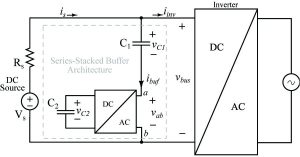Active Power Decoupling in High Power Density Single-Phase DC-AC and AC-DC Converters
Nathan Brooks with advisor Prof. Robert Pilawa-Podgurski
Single-phase ac-dc and dc-ac converters have fundamental power processing limitations at twice the ac line frequency. The conventional solution for twice-line cycle energy storage utilizes a large dc link capacitor across the dc bus to buffer the instantaneous energy difference between the ac and dc side. This research involves employing high power density converters to actively buffer the twice-line energy across the dc bus. Higher overall buffer power density is achieved by switching at higher frequencies with GaN devices. The tradeoff of active power decoupling compared to conventional passive methods is an overall higher power density of the system and lower voltage ripple on the dc bus.

Figure 29: Prototype of buffer converter with GaN switching devices and thin film energy storage capacitors
A series-stacked buffer architecture is proposed to supply the instantaneous twice-line current ripple required by the dc side of the ac-dc or dc-ac converter. A schematic is shown in Fig. 28 for an ac-dc converter architecture. Fig. 29 shows the hardware prototype of the buffer converter designed with the use of GaN switching devices and thin film energy storage capacitors. This research is supported by Texas Instruments.
